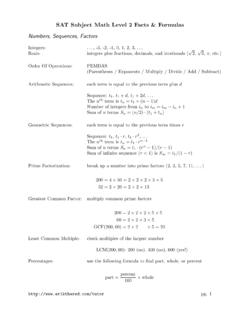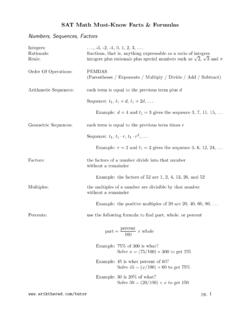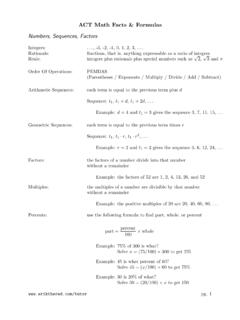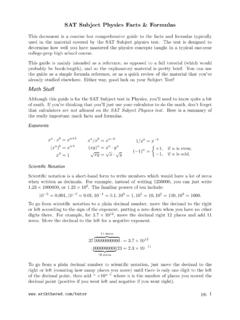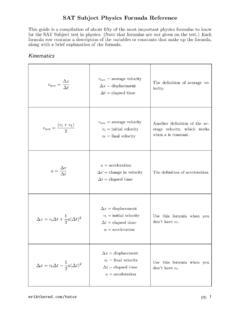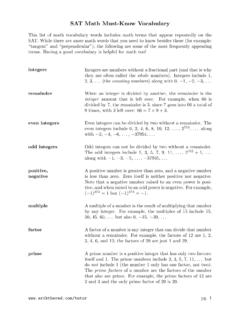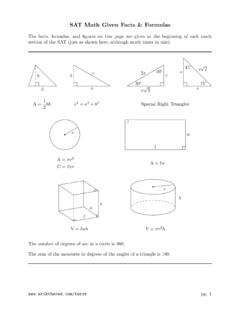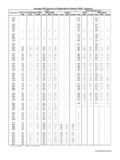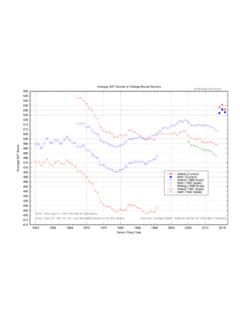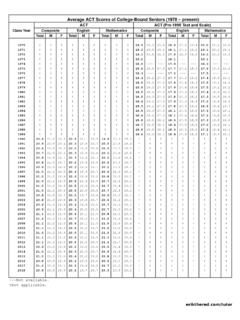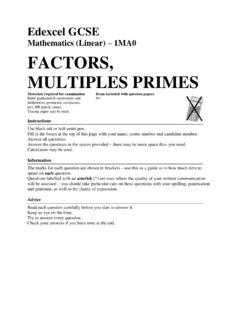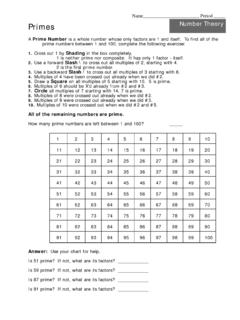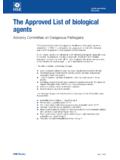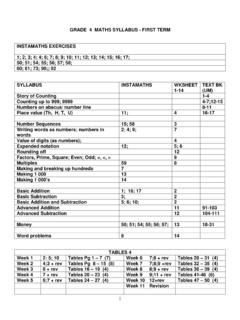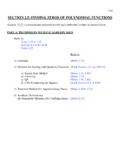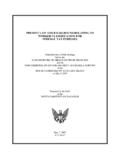Transcription of ACT Math Facts & Formulas Numbers, Sequences, …
1 ACT Math Facts & FormulasNumbers, Sequences, FactorsIntegers:.., -3, -2, -1, 0, 1, 2, 3,..Rationals:fractions, that is, anything expressable as a ratio of integersReals:integers plus rationals plus special numbers such as 2, 3 and Order Of Operations:PEMDAS(Parentheses / Exponents / Multiply / Divide / Add / Subtract)Arithmetic Sequences:each term is equal to the previous term plusdSequence:t1,t1+d,t1+ 2d,..Example:d= 4 andt1= 3 gives the sequence 3, 7, 11, 15,..Geometric Sequences:each term is equal to the previous termtimesrSequence:t1,t1 r,t1 r2,..Example:r= 2 andt1= 3 gives the sequence 3, 6, 12, 24,..Factors:the factors of a number divide into that numberwithout a remainderExample: the factors of 52 are 1, 2, 4, 13, 26, and 52 Multiples:the multiples of a number are divisible by that numberwithout a remainderExample: the positive multiples of 20 are 20, 40, 60, 80.
2 Percents:use the following formula to find part, whole, or percentpart =percent100 wholeExample: 75% of 300 is what?Solvex= (75/100) 300 to get 225 Example: 45 is what percent of 60?Solve 45 = (x/100) 60 to get 75%Example: 30 is 20% of what?Solve 30 = (20/100) xto get 1 ACT Math Facts & FormulasAverages, Counting, Statistics, Probabilityaverage =sum of termsnumber of termsaverage speed =total distancetotal timesum = average ( number of terms)mode = value in the list that appears most oftenmedian = middle value in the listmedian of{3,9,10,27,50}= 10median of{3,9,10,27}= (9 + 10)/2 = Counting Principle:If an event can happen inNways, and another, independent eventcan happen inMways, then both events together can happen inN Mways. (Extend this for three or more:N1 N2 N3..)Probability (Optional):probability = number of desired outcomesnumber of total outcomesExample: each ACT math multiple choice question hasfive possible answers, one of which is the correct you guess the answer to a question completely at ran-dom, your probability of getting it right is 1/5 = 20%.
3 The probability of two different eventsAandBbothhappening isP(AandB) =P(A) P(B), as long as the events are independent(not mutually exclusive).Powers, Exponents, Rootsxa xb=xa+b(xa)b=xa bx0= 1xa/xb=xa b(xy)a=xa ya xy= x y1/xb=x b( 1)n={+1,ifnis even; 1,ifnis 2 ACT Math Facts & FormulasFactoring, Solving(x+a)(x+b) =x2+ (b+a)x+ab FOIL a2 b2= (a+b)(a b) Difference Of Squares a2+ 2ab+b2= (a+b)(a+b)a2 2ab+b2= (a b)(a b)x2+ (b+a)x+ab= (x+a)(x+b) Reverse FOIL You can use Reverse FOIL to factor a polynomial by thinking about two numbersaandbwhich add to the number in front of thex, and which multiply to give the constant. Forexample, to factorx2+ 5x+ 6, the numbers add to 5 and multiply to 6, ,a= 2 andb= 3, so thatx2+ 5x+ 6 = (x+ 2)(x+ 3).To solve a quadratic such asx2+bx+c= 0, first factor the left side to get (x+a)(x+b) = 0,then set each part in parentheses equal to zero.}
4 ,x2+ 4x+ 3 = (x+ 3)(x+ 1) = 0 sothatx= 3 orx= solve two linear equations inxandy: use the first equation to substitute for a variablein the second. , supposex+y= 3 and 4x y= 2. The first equation givesy= 3 x,so the second equation becomes 4x (3 x) = 2 5x 3 = 2 x= 1, y= two linear equations inxandyis geometrically the same as finding where two linesintersect. In the example above, the lines intersect at the point (1,2). Two parallel lineswill have no solution, and two overlapping lines will have aninfinite number of function is a rule to go from one number (x) to another number (y), usually writteny=f(x).The set of possible values ofxis called thedomainoff(), and the corresponding set ofpossible values ofyis called therangeoff(). For any given value ofx, there can only beone corresponding value:|x|={+x,ifx 0; x,ifx < 3 ACT Math Facts & FormulasLogarithms (Optional):Logarithms are basically the inverse functions of exponentials.}
5 The function logbxanswersthe question:bto what power givesx? Here,bis called the logarithmic base . So, ify= logbx, then the logarithm function gives the numberysuch thatby=x. For example,log3 27 = log3 33= log333/2= 3/2 = Similarly, logbbn= useful rule to know is: logbxy= logbx+ NumbersA complex number is of the forma+biwherei2= 1. When multiplying complexnumbers, treatijust like any other variable (letter), except remember to replace powersofiwith 1 or 1 as follows (the pattern repeats after the first four):i0= 1i4= 1i1=ii5=ii2= 1i6= 1i3= ii7= iFor example, using FOIL andi2= 1: (1 + 3i)(5 2i) = 5 2i+ 15i 6i2= 11 + (Linear Functions)Consider the line that goes through pointsA(x1, y1) andB(x2, y2).Distance fromAtoB: (x2 x1)2+ (y2 y1)2 Mid-point of the segmentAB:(x1+x22,y1+y22)Slope of the line:y2 y1x2 x1=riserunPoint-slope form: given the slopemand a point (x1, y1) on the line, the equation of theline is (y y1) =m(x x1).
6 Slope-intercept form: given the slopemand the y-interceptb, then the equation of theline isy=mx+ find the equation of the line given two pointsA(x1, y1) andB(x2, y2), calculate theslopem= (y2 y1)/(x2 x1) and use the point-slope lines have equal slopes. Perpendicular lines ( , those that make a 90 anglewhere they intersect) have negative reciprocal slopes:m1 m2= 4 ACT Math Facts & Formulasa b a b mla b a b a b a b Intersecting LinesParallel Lines (lkm)Intersecting lines: opposite angles are equal. Also, each pair of angles along the same lineadd to 180 . In the figure above,a+b= 180 .Parallel lines: eight angles are formed when a line crosses two parallel lines. The four bigangles (a) are equal, and the four small angles (b) are triangles:abcx 3x2x30 60 xxx 245 45 a2+b2=c2 Special Right TrianglesA good example of a right triangle is one witha= 3,b= 4, andc= 5, also called a 3 4 5right triangle.
7 Note that multiples of these numbers are also right triangles. For example,if you multiply these numbers by 2, you geta= 6,b= 8, andc= 10 (6 8 10), which isalso a right triangles:hbArea =12 b 5 ACT Math Facts & FormulasAngles on the inside of any triangle add up to 180 .The length of one side of any triangle is alwayslessthan the sum andmorethan thedifference of the lengths of the other two exterior angle of any triangle is equal to the sum of the tworemote interior important triangles:Equilateral: These triangles have three equal sides, and all three angles are 60 .Isosceles:An isosceles triangle has two equal sides. The base angles(the ones opposite the two sides) are equal (see the 45 triangle above).Similar:Two or more triangles are similar if they have the same shape. Thecorresponding angles are equal, and the corresponding sidesare in proportion.
8 For example, the 3 4 5 triangle and the 6 8 10triangle from before are similar since their sides are in a ratio of 2 to to the figure below, there are three important functions which are defined forangles in a right triangle:adjacentoppositehypotenuse sin =oppositehypotenuse SOH cos =adjacenthypotenuse CAH tan =oppositeadjacent TOA (the last line above shows a mnemonic to remember these functions: SOH-CAH-TOA )Optional: A useful relationship to remember which works forany angle is:sin2 + cos2 = example, if = 30 , then (refer to the Special Right Triangles figure) we have sin 30 =1/2, cos 30 = 3/2, so that sin230 + cos230 = 1/4 + 3/4 = 6 ACT Math Facts & FormulasCircles(h, k)rn rArcSectorArea = r2 Circumference = 2 rFull circle = 360 Length Of Arc = (n /360 ) 2 rArea Of Sector = (n /360 ) r2 Equation of the circle (above left figure): (x h)2+ (y k)2= way to measure angles is with radians.
9 These are defined such that radians isequal to 180 , so that the number of radians in a circle is 2 (or 360 ).To convert from degrees to radians, just multiply by /180 . For example, the number ofradians in 45 is , since 45 /180 = /4 rad And FriendsRectangles and Parallelograms:lwhlwRectangleParallelogr am(Square ifl=w)(Rhombus ifl=w)Area =lwArea =lhTrapezoids (Optional):hbase1base2 Area of trapezoid =(base1+ base22) 7 ACT Math Facts & FormulasSolids (Optional)lwhrhRectangular SolidRight CylinderVolume =lwhVolume = 8
